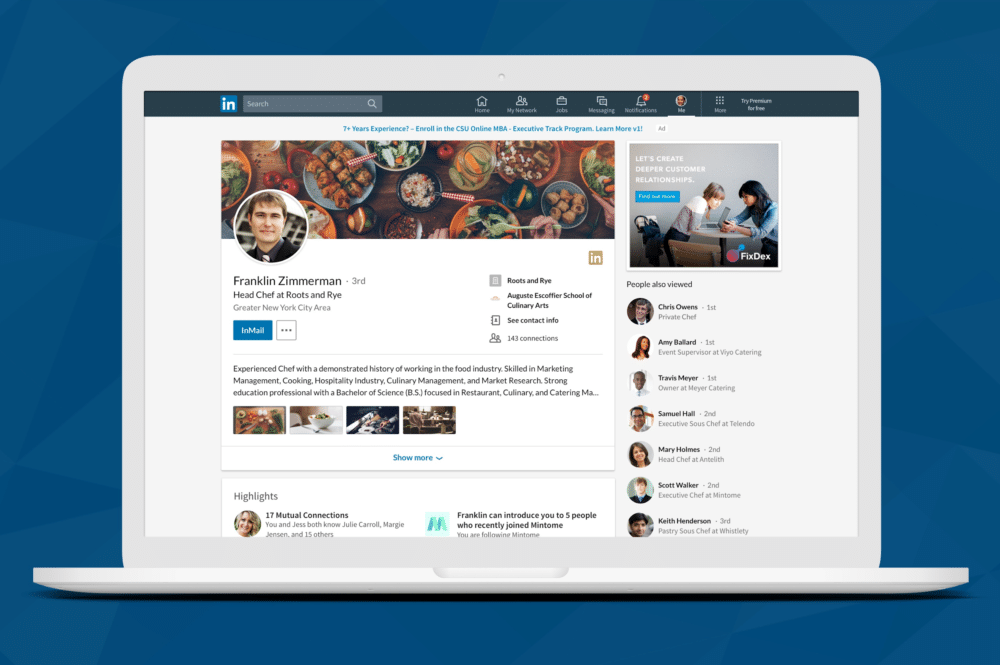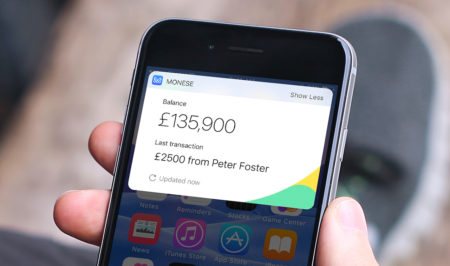Every freelancer knows how hard it is to find a job these days. It doesn’t matter if you have just started freelancing or if you are a seasoned vet, finding that new gig is never easy. While some freelancers prefer to use freelance job sites, others rely on sending out cold emails.
However, there is one more option to consider—LinkedIn. By definition, LinkedIn is a social network oriented towards professionals looking for jobs and employees. If you want to get freelance gigs on LinkedIn, simply creating a profile is not enough.
You also need to invest some time in optimizing your LinkedIn profile as a freelancer. The most important aspect of editing your profile on LinkedIn as a freelancer is to list your freelance or contract work in an effective way. Having a proper LinkedIn profile could help you get positive responses from clients quickly.
So in this post, we’ll show you how to list freelance work on LinkedIn so that you get more opportunities with less effort.
Money Note: If an extra $1K–$5K/month would change your 2026 goals (debt, savings, travel, freedom), you’ll want to catch this: free live workshop from a freelancer who’s earned $4M+ online. No fluff. No gimmicks. A real roadmap. 👉 Watch the training or save your seat here »
Why should you use LinkedIn for freelance work?
With 310 million active users, including loads of major corporations, LinkedIn is one of the best, if not the best, online platforms for freelancers or anyone else looking for that next job or gig. If you only have time for one social media platform, make sure it’s LinkedIn.
LinkedIn is probably the only online platform where you can ask: “Hey, do you know if anyone needs a graphic designer?” without anyone batting an eye.
LinkedIn is the place online where everyone goes to do business networking, which means that it is perfectly fine to market yourself and pitch your services and products to others. Of course, to improve your chances of landing that next freelance gig, you need to list all your freelance work properly.
The four most visible components of any LinkedIn profile are your profile picture, name, location, and headline. They are also the first things anyone sees when they run into your profile on LinkedIn. That’s why it’s important to optimize these four things in a way that helps you land that job.
While you can’t do much about your location or your name, your profile picture and your headline can be edited for success.
1. Profile picture
It only takes a few milliseconds to draw conclusions about people based on their photos. This means that if you are using LinkedIn for sales, it’s important to put your best face forward. Here are a few quick tips for ensuring that your LinkedIn profile picture impresses people:
- Never use your old photos from Facebook. Make sure that your profile picture represents you in a business setting.
- Make sure that your background is neutral coloured; a brick wall or even some greenery also works great. Also, don’t stand in front of something that will draw attention away from you.
- Smile and show your teeth. People that are smiling almost always look more approachable, which is an important characteristic most employees are looking for.
- Dress appropriately when taking your LinkedIn profile photo. While wearing a suit isn’t mandatory, your old sweater or yoga pants are definitely not representative of a professional.
- When editing your photo, make sure you crop it at your shoulders or your waist. Because of the way LinkedIn is designed, full-body shots are almost unrecognizable in such a small thumbnail.
2. Headline
Next to your profile picture, your headline is what most people will first notice when they see your profile on LinkedIn. Your headline should draw in people to take a look at your profile. To do this, make sure that your headline is a quick and short summary of what you do.
When people search for potential freelancers on LinkedIn, the results they get are based on specific keywords. Including keywords that are relevant to what you do is a must.
However, make sure you don’t use too much industry jargon as it might scare away some people because it doesn’t sound like a real human being wrote that headline.
The headline for all people on LinkedIn set by default is their current position and their company. If you are seeking out freelance work and your headline says that you are an employee somewhere, employers are going to assume that you aren’t looking for a freelance gig and they will scroll past your profile.
Your headline should be a representation of what you do best, written in a way that attracts your ideal client. When writing your headline, focus on addressing your clients’ biggest pain points and tell them why hiring you will fix them.
Listing your freelance work starts with your Summary section
Once you’ve edited your profile picture and headline so they make a great first impression, you are ready to start working on the next step in the how to list freelance work on the LinkedIn process — your profile and showcasing your freelance work.
Just under your profile picture, name, headline, and location is your summary. This is the place where you should list your accomplishments.
1. Use your Summary section to list what you’re about
Your summary is a 2,000 characters long text box LinkedIn has intended to be about yourself. Make sure you use that limit to the maximum and describe what you do while also showcasing your communication and presentation skills by writing your summary in a concise and clear way.
Your summary is also the place to include any relevant keywords your clients might search for that didn’t fit into your headline.
Also, make sure that your summary includes a description of your services, a list of your most proud accomplishments, and clients you have worked with in the past.
2. Add client testimonials to your Summary
Just as your services, accomplishments, and a list of clients is important for getting freelance work on LinkedIn, adding testimonials to the “about” section of your profile is equally important.
Getting client testimonials is not always easy, but there is one thing you can do to speed up the process: write them yourself then email the client and ask for their approval.

If they approve, put the testimonials at the bottom of your summary.
3. Put your best work in your Featured section
Knowing how to list freelance work on LinkedIn will help you stand out among other freelancers. The best way to make your profile stand out to potential clients is to show them what you can do for them right on the spot without having them go anywhere else.
To do this, you need to bring all project info and work samples to the Featured section on top of your LinkedIn profile.
The Featured section allows you to showcase samples of your work. You can feature different types of content in this section such as LinkedIn posts, links to external websites, media files, and articles published on LinkedIn.
Choosing the right type of content will largely depend on the work you do. If you are a writer, featuring LinkedIn posts or articles that you have authored or links to your published articles is a great option.
If you are an illustrator or a video editor, you can upload images or videos that showcase your skills. You can also link to an external website, such as your portfolio or showcase.
How to List Freelance Work on LinkedIn Experience Section
Together with your headline and summary, the Experience section is one of the most important sections of your profile on LinkedIn. It allows you to showcase your work history and it is a great place to sell your services to potential clients.
1. Create a company profile for your freelance work
Many people list the companies they work for under Experience. If you are a freelancer, listing every company you have worked for could be time-consuming for you and confusing for clients.
If they see a lot of short-term jobs not labeled as freelance work, it might scare them away from your profile.
Plus, if you are under NDA contracts, you most likely can’t even disclose the companies you have worked with. What you want to do instead is create a company profile for your freelance work and list all your important projects and clients under it.
The extra 15 minutes it takes to create a company page on LinkedIn, add a location, logo, write up a description, and list your specializations can significantly help you in the long run.
Plus, you can write posts using your company profile, which means that clients could follow your company on LinkedIn for updates. Your posts might even end up in the feeds of your potential clients who decide to contact you.
2. Attach work samples directly to your listed experience
Similar to your Featured section, you can easily attach media, links, or PDFs to a listed experience. Because this is a feature used by few people, it will make your profile stand out even more. The attachment could be a specific work sample related to that listed experience or it could be a lead magnet.

If you already have case studies, this is a great place to showcase them.
3. Get recommendations from clients
Your listed freelance work could take on multiple shapes and forms, one of which is a LinkedIn recommendation. Simply use the “Ask for a Recommendation” feature on LinkedIn and ask the clients you have worked with in the past to provide a testimonial and recommend you to future clients. Make sure that the request is personalized and that includes specific pointers on what the recommendation should look like.
You can also try to get a reciprocation effect going by giving recommendations to clients or freelancers you have worked with in the past. It might convince them to do the same for you.
How to list freelance work on LinkedIn using content
Over the years, LinkedIn has gone through major changes. What once was a platform to showcase your resume is now a full-fledged social network with all the features that other social networks have, including the ability to write, read, share and comment on content.
1. Write posts and comments about your freelance work
Getting started with posting content on LinkedIn takes a bit of courage and preparation but it could be very useful for you and your business in the long run. Start by writing about your most recent accomplishments and the projects you have worked on.
While you don’t want to sound like you are bragging, you want your current and potential clients to see that you are proud of the work you do.
Also, don’t write something that looks like it was recycled from somewhere else. You can start with an introductory post and briefly write about yourself and what you do. You can also talk about current industry matters or you can share your knowledge with others.
For your introductory post, you can talk about what you can do for clients and why you are the person they should work with. Grabbing the attention of people on LinkedIn is not easy and it will take some time for you to get good at it. Whatever content you decide to write in the end, make sure that you are genuine, as honesty is valued in business and on social media.
Other ways to get work on LinkedIn
Setting up a proper LinkedIn profile will take some time. But even with a great LinkedIn profile, chances are that clients won’t simply land in your lap. Instead, you should be the one that initiates the conversation. Here are a few ways to do it.
1. Keyword search
A great way to find freelance opportunities in your niche is to search for them on LinkedIn. Try your industry’s specific keywords or “seeking freelancer” and you will be surprised by what you could end up finding. Even if you don’t end up landing a gig, you will still get in front of decision-makers in your industry.
2. Use Slideshare and Pulse
SlideShare is the place to post professional presentations, documents, videos, and infographics. Sharing your case studies or portfolio work can help you build your reputation and bring your more freelance work.
Pulse is LinkedIn’s publishing platform. You can use it to follow thought leaders and influencers from your industry. Chances are that you will come across prospects on Pulse, as they are most likely following the same people you are following.
3. Automation
Since LinkedIn is used by many decision-makers every day, it is one of the best sales environments a freelancer could ask for. LinkedIn advertising, no matter if your creating ads or doing it through your profile by connecting with people you are interested in working with and sending them an attention-grabbing message will take time.
However, you can speed this up by using LinkedIn automation software. These tools can help you build a better professional network faster.
With an automation tool, you can make connections faster, find prospective clients by extracting emails from LinkedIn, run outreach campaigns towards prospects, and can easily publish the right content to your audience at the right time.
4. LinkedIn Groups
Even though at a first glance LinkedIn Groups seems to be a feature that never took off, many people use them to make connections with prospective clients and get work. If you decide to use this feature, make genuine connections with people in the groups and don’t be spammy with your posts, comments, or offers.
Winning business on LinkedIn
Because LinkedIn is the only major social network intended for business, the competition is tough—there is no doubt about it. However, you should use the popularity of LinkedIn for yourself. While yes, many freelancers are on LinkedIn, so are a bunch of decision-makers and prospective clients.
The tough competition might prove not to be so tough in the end as a majority of them don’t have an optimized profile or feature any of their work.
This is your ticket to winning business on LinkedIn. Having a profile that stands out from the rest with a great profile picture, headline, and listed freelance work will sure help you get more business.
Keep the conversation going...
Over 10,000 of us are having daily conversations over in our free Facebook group and we'd love to see you there. Join us!






